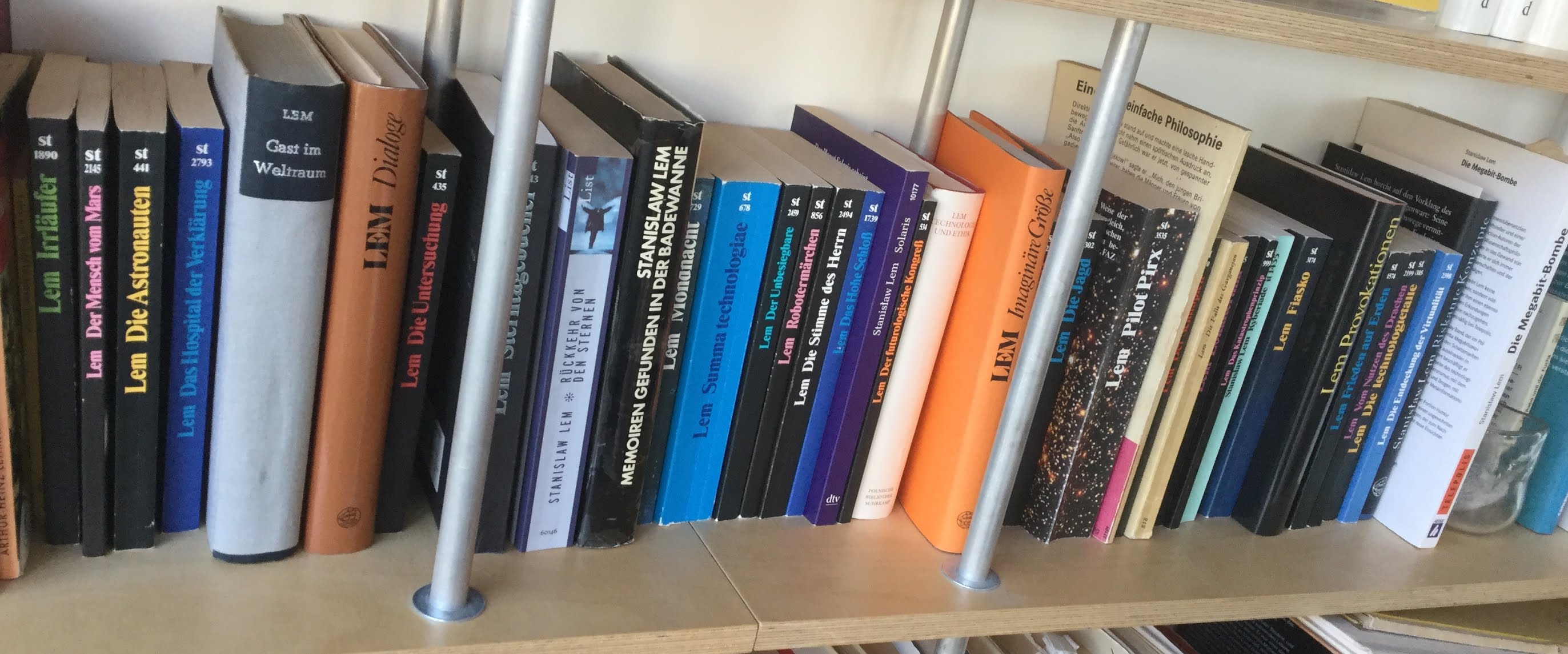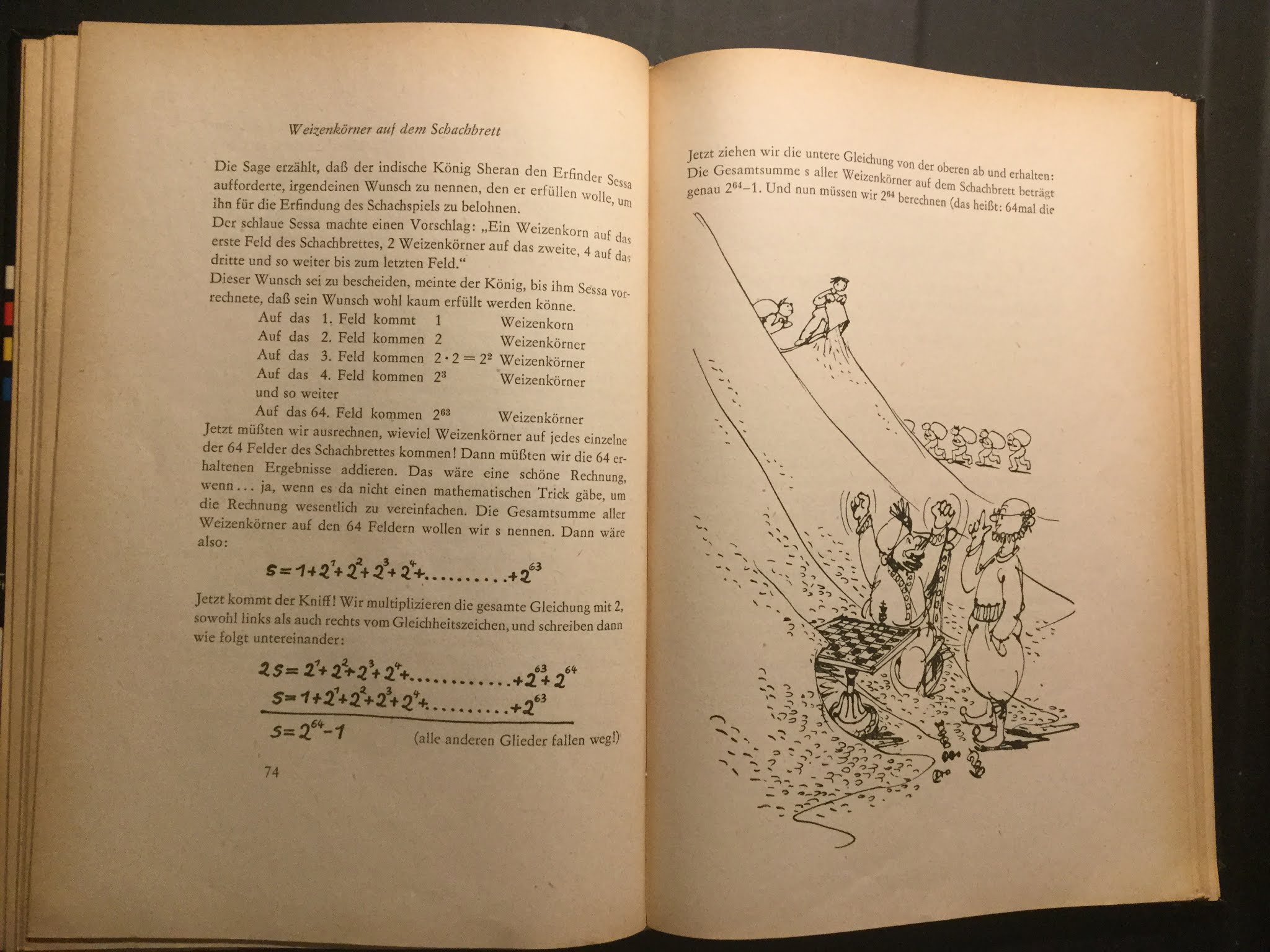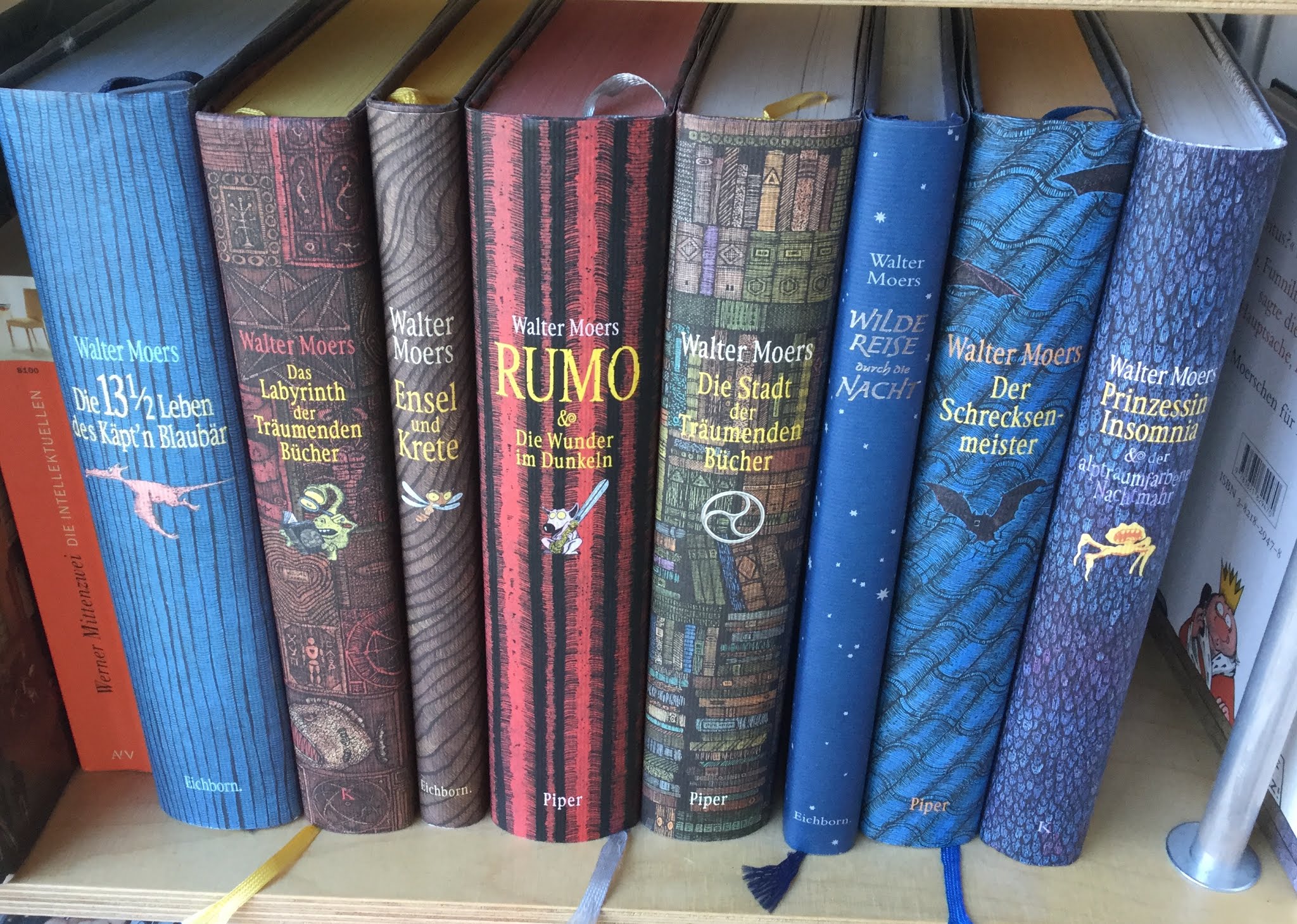Some weeks ago, a friend invited me on Twitter to take part in the #BookChallenge. You’ve probably heard about it: people post covers of their favorite books for seven days, one book per day. It runs in various languages and usually includes a statement like “7 days, 7 favorite books, no explanations,” you mention the person who invited you and you might invite or challenge somebody else. A really nice version of a chain letter, I think.
I accepted the challenge by Ruth Mell:
#BookChallenge 7 days, 7 favorite books Challenged by @KonstanzeMarx 2/7 Ein unterschätztes Buch. Die Charaktere sind einfach großartig! I invite @CerstinMahlow pic.twitter.com/tdT71bgqE0
— Ruth M. Mell (@Ninchen2) 6. November 2018
And I posted 9 books, you can find all of my tweets via Twitter Search.
Wait, why 9? Because I’ve read so many books that are important for me, I didn’t manage to reduce their number to 7 in the end.
I’d like to give some explanations on the books I posted—and on the books I finally didn’t post. I’ll explain them in a different order than I originally posted them, though.
I’ve always loved reading, and as a kid I always had a book with me. When you just start reading, blackletter is quite difficult. So my grandmother read these old children’s books with me: we were both sitting in a really wide armchair, looking at the book, and she was reading aloud. The armchair was placed near the heating and we probably also had some snacks and cocoa or coffee. When we went on vacation, it was a hard fight every time about how many and which books I could take with me—we were traveling by train and somebody had to carry those books in the end. So, of course I wanted to include at least one of the books from these days. I love everything by Benno Pludra (“Bootsmann auf der Scholle,” “Heiner und seine Hähnchen,” etc.), the children’s books by Christoph Hein (e.g., “Das Wildpferd unterm Kachelofen”), Alfred Wellm (e.g., “Das Pferdemädchen”) and Fred Rodrian (e.g., “Das Wolkenschaf,” “Schwalbenchristine”) and so on. Later I read all books about American Indians by Liselotte Welskopf-Henrich (all the volumes of “Die Söhne der Großen Bärin” and “Das Blut des Adlers”)—some of them I received as gifts, some of them my grandfathers had bought for themselves—and of course all books by Karl May one could buy (which was a bit of an issue in the GDR: partly because of the dispute about publication rights and partly because of the low number of books printed in the GDR). But finally, I decided to post “Geschichten aus der Murkelei” by Hans Fallada, with illustrations by Conrad ‘Conny’ Neubauer. Printed in 1960, it’s a book my father got when he was a kid.
It’s a collection of short stories Fallada first told his kids and then later wrote down. The stories contain all kinds of nonsense: there are days turned upside down, caps that make you invisible, and my favorite story “Mäuseken Wackelohr.” This is the story of a little mouse with an ear that’s a bit jagged, and who finally succeeds in getting into the house across the street despite the cat, and with the help of ants (who do everything for candies) and doves.
I also love the radio play from 1980 with all the great actors of the time!
An author I really like is Neal Stephenson. I chose “Reamde,” which is not his latest book but the one I read most recently:
The two books published after “Reamde” are still waiting for me on the “To Read” shelf. When I first discovered Stephenson, I read the novels in their German translations. Starting with the Baroque Cycle, I’ve been reading his books in their original English versions. Maybe I should get the first ones in English, too, as I really like his style. I like him as a writer since he writes (or at least used to write) using Emacs, and I admire how he manages to create futuristic or historical places and scenarios that are totally reasonable and plausible. He also wrote about more technical stuff like “In the Beginning was the Command Line” or “Mother Earth Mother Board.”
The ability to write about futuristic sceneries with a scientific touch—there is no magic, it’s all very plausible, and can be explained by scientific reasoning—is even more prominent in the novels and stories by Stanisław Lem. I think I have all of his books that have been translated into German.
The book I chose was “Gast im Weltraum” (“The Magellanic Cloud,” original Polish title: “Obłok Magellana”):
It’s from the 1950s and this copy was one of my grandfather’s books. I don’t remember when I first read it—my grandfather died when I turned 7—but I inherited it from him, and so he somehow introduced me to science fiction and cybernetics (OK, that’s stretching it a bit, especially since he was a musician). I recently discovered that the version published at the time had been censored and that the original version was only published in the 1990s—unfortunately it seems that there’s no English or German translation of this version.
Lem published essays and stories covering neural networks, nanotechnology, the Internet, artificial intelligence, etc., long before these things existed, and he predicted and explained everything in a way that lets you read his publications from the 1960s and 1970s just like very recent books on contemporary topics. He continued writing even as an old man, and the essays from the volume “Die Megabit-Bombe” (“The Megabit Bomb,” original: “Bomba megabitowa”) from 1999 discuss technical, and even more importantly, ethical issues that are highly relevant today! So I included this book, too, as a sidekick.
When you discuss the effects and impacts of the digital transformation in the humanities, in science, in politics and society, you should read those essays! It seems that they have been only translated into German and Russian, though.
I discovered Bret Easton Ellis when I was 17 or so. I read the German translation of his book “American Psycho.”
At that time, the book was on the index in Germany (which meant that it was not allowed to be advertised and not to be sold to customers younger than 18), but IIRC my father had received a review copy from a newspaper before the book was put on the index. Both of us liked the book very much—both of us didn’t like my German teacher at school. When one could write a somewhat longer essay to substitute for one of the written exams I decided to write about the “image of the American society in the early 1990s as described in contemporary novels.” I used “American Psycho” and “Leviathan” by Paul Auster. And I included extensive samples from “American Psycho,” so my teacher was forced to read it—and I knew she didn’t like splatter movies and horror scenes. It was a bit mean, I guess. However, this book is also the first novel I read in English—I wanted to read the original version. It was impossible to get in Germany, so I asked one of my schoolmates—the son of the pastor—who was about to go to the US for a summer camp whether he could buy the book for me. And he did; he never commented on it, though :)
I liked Genesis and Phil Collins already before I read the book, but based on Ellis’s extensive reviews, I bought specific albums, first on cassette and later on CD. Much, much later I discovered Ellis’s account on Twitter and followed him. And in summer 2013, he posted a recommendation for a book I only bought because of his recommendation, and I didn’t regret it: “Stoner” by John Williams.
I’ve read “Franziska Linkerhand” by Brigitte Reimann in the new unabridged edition from 1998 with an extensive afterword by Withold Bonner. There was a first edition in 1974 (one year after Reimann had died at the age of 39) which had been censored and edited a lot—and as Brigitte Reimann wrote in her diaries, she herself had censored and changed a lot during writing after “helpful and friendly” exchanges with lectors and other writers. This new edition ends with the unfinished pages and sentences by Reimann: there is no end of the novel. Maybe it’s true that, from a literary point of view, Reimann would have had to revise the whole book to find a proper ending anyway; it’s true that the story somehow gets stuck in the end.
Franziska Linkerhand is a young architect trying to find her way in the 60s in the GDR, in the building sites of one of those cities that were thrown up to house mineworkers. I recommend reading the novel together with Reimann’s diaries “Ich bedaure nichts” (1955 to 1963) and “Alles schmeckt nach Abschied” (1964 to 1970), so you can understand why Franziska acts as she does. And there is also a nice edition of letters she exchanged with Hermann Henselmann (“Mit Respekt und Vergnügen”, published 2001), one of the most influential architects of the GDR (he’s the architect of the Stalinallee boulevard in Berlin, for example), you should read to understand the construction-related political scenes. And in the letters with Christa Wolf from 1964 to 1973 (“Sei gegrüßt und lebe”, published 1993), you can follow how Reimann struggled with writing and finding ways for her protagonist. I read the book again this summer while commuting and I always forgot the time and completely immersed in the book and in the time. I didn’t live during the time Reimann describes, but the cities and streets were close to reality even 20 years later. And also the arguments of politicians and superiors were still the same, as was the killer argument: you surely are in favor of peace (or even world peace!), aren’t you?
“Jahrestage” by Uwe Johnson I read during my last school year. It took some time and I showed up with one of those black books wherever I went, I even read when waiting at the traffic lights. I had read other novels by Johnson before, I liked his style and I could understand the Low German and the Russian snippets he used. And of course I liked and I still like the Baltic Sea, Mecklenburg, and those small towns and villages Johnson describes. He writes in a way the people in the North speak and react: very reduced, a bit uncommunicative.
“100 Eier des Kolumbus” by Dr. Gerhard Niese, printed in 1962, is one of my mother’s children’s books.
It contains magic tricks, mathematical, physical, and chemical experiments or problems, nicely illustrated by Heinz-Karl Bogdanski. I actually used it when working on problems in the math club as the explanations were much better than the ones given by my teachers or in the school books.
“Maus” by Art Spiegelman was the first comic I read. I had never been into comics as a kid, no Digedags, no Abrafaxe, let alone Asterix or Spirou. “Maus“ had been on the index in Germany as well—just because there are swastikas all over, but how would you tell/draw the story of the Holocaust without showing Nazi symbols?
Spiegelman tells about talking with his father—a survivor of the Holocaust—about his experiences and he tries to understand what had happened and why his father is now the way he is. It is very impressive and very depressing. Much later I bought the book where Spiegelman documents the making of “Maus,” also as a comic.
And then there are other books and authors I find important and that I considered—but which eventually didn’t make it into the final nine.
When it comes to children’s books, I also always liked “Lustige Geschichten” (original Russian title: “Забавные истории”) by Wladimir Sutejew.
Especially as he was able (or at least that’s what he told his readers) to draw and write at the same time!
The fairy tales of the Brothers Grimm in an old edition, printed in 1954. Originally my mother received it as a gift when she was a kid.
My grandfather used to do fretwork. He did “Rotkäppchen” (“Little Red Riding Hood“) for me and he used the illustration in the book as a master. It used to hang in my bedroom.
The first North American author I discovered was John Irving in the early 1990s, and the first novel I read was “A Prayer for Owen Meany” (in the German translation published as “Owen Meany”). But as this book isn’t mine but my father’s I couldn’t take a picture of the cover for the challenge.
Over the years, I’ve read more of Irving’s novels, and as for Ellis and Stephenson, I regularly check whether he’s published something new and then go and get it. So there are also some novels of his waiting on my “To Read” shelf.
And then all the great books by Walter Moers!
I also regularly check for new books by him. His novels are full of fantastic adventures, crazy twists, and creative names and descriptions. They’re like fairy tales for grown-ups. And the books are also nicely done when it comes to typography and layout.
An author I only recently discovered is Stefan Heym. I discovered him by chance while diving into literature on architects and architecture in the GDR, and Hermann Henselmann in particular. Heym wrote “The Architects” in the 1960s, and it discusses many of the same things as the movie “Spur der Steine” and Brigitte Reimann’s novel “Franziska Linkerhand,” which were also censored and/or banned in the GDR, so it does not come as a surprise that the German translation was only published in 2000, shortly before he died (the English original was published in 2005).
This got me interested and I began reading more, Heym’s autobiography “Nachruf” and more of his novels. And I reread “Franziska Linkerhand.”
As I strolled by my bookshelf, I discovered many other books I think I should read again. So, thanks for this challenge that got me thinking about my books!







